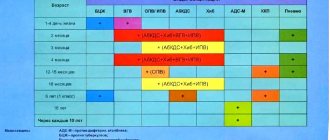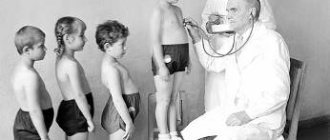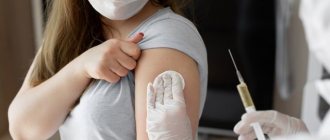National calendar prof. vaccinations
DECISION OF THE MINISTRY OF HEALTH OF THE REPUBLIC OF BELARUS
May 17, 2021 No. 42
About preventive vaccinations
Based on part four of Article 24 of the Law of the Republic of Belarus dated January 7, 2012 “On the sanitary and epidemiological welfare of the population”, subparagraph 9.1 of paragraph 9 of the Regulations on the Ministry of Health of the Republic of Belarus, approved by Resolution of the Council of Ministers of the Republic of Belarus dated October 28, 2011 No. 1446 “On some issues of the Ministry of Health and measures to implement the Decree of the President of the Republic of Belarus of August 11, 2011 No. 360", the Ministry of Health of the Republic of Belarus DECIDES:
1. Install:
National calendar of preventive vaccinations according to Appendix 1; list of preventive vaccinations for epidemic indications according to
appendix 2.
2. Determine that:
2.1 preventive vaccinations in accordance with the National Calendar of Preventive Vaccinations are carried out at certain periods of a person’s life, regardless of the epidemiological situation, to create specific immunity of the human body to the relevant infectious diseases;
2.2 for the purposes of this resolution, epidemic indications mean:
- being in contact with a patient suffering from an infectious disease (suspected of an infectious disease), against whom preventive vaccinations are carried out;
- the presence, when carrying out professional activities, of the risk of infection by pathogens of infectious diseases, against which preventive vaccinations are carried out;
- the presence, in conditions of an unfavorable sanitary and epidemiological situation in the Republic of Belarus or on the territory of its individual administrative-territorial units, as well as on the territory of other states, of the risk of infection by pathogens of infectious diseases against which preventive vaccinations are carried out;
- the presence of the possible introduction of infectious diseases into the territory of the Republic of Belarus of the risk of infection by pathogens of infectious diseases against which preventive vaccinations are carried out;
- the presence of diseases (conditions) in which infection with pathogens of infectious diseases against which preventive vaccinations are carried out can lead to a complicated course of these diseases (conditions) or death;
2.3 preventive vaccinations are carried out in state health care organizations, as well as in non-state health care organizations that have a special permit (license) to carry out medical activities, issued in the manner established by the legislation of the Republic of Belarus on licensing. Information about preventive vaccination is entered into the patient’s medical documents by the medical professional who directly performed it;
2.4 in case of refusal of the patient (in cases provided for by the legislation of the Republic of Belarus - the person specified in part two of Article 18 of the Law of the Republic of Belarus of June 18, 1993 “On Health Care” (Vedamasti Vyarkhoonaga Saveta
Republic of Belarus, 1993, No. 24, art. 290; National Register of Legal Acts of the Republic of Belarus, 2008, No. 159, 2/1460) from carrying out preventive vaccination by the attending physician must explain in an accessible form the possible consequences of refusing preventive vaccination. Refusal from preventive vaccination is recorded in the patient’s medical documents and signed by the patient (the person specified in part two of Article 18 of the Law of the Republic of Belarus “On Health Care”) and the attending physician;
2.5 preventive vaccinations are carried out taking into account the indications and contraindications for their implementation, in strict accordance with the instructions for medical use attached to the immunobiological medicinal product;
2.6 before carrying out preventive vaccination, a specialist doctor conducts a medical examination of the person and records its results in medical documents;
2.7 the medical worker of the healthcare organization who administered the preventive vaccination to the person monitors him for 30 minutes after the administration of the immunobiological medicinal product.
3. To recognize as invalid:
Resolution of the Ministry of Health of the Republic of Belarus dated July 18, 2012 No. 106 “On the establishment of the National Calendar of Preventive Vaccinations, a list of preventive vaccinations for epidemic indications, the procedure and timing of their implementation and the invalidation of the resolutions of the Ministry of Health of the Republic of Belarus dated September 29, 2006 No. 76 and dated August 8, 2011
No. 78" (National Legal Internet Portal of the Republic of Belarus, 08/10/2012, 8/26238);
Resolution of the Ministry of Health of the Republic of Belarus dated February 12, 2021 No. 25 “On introducing additions and changes to the Resolution of the Ministry of Health of the Republic of Belarus dated July 18, 2012 No. 106” (National Legal Internet Portal of the Republic of Belarus, 03/12/2016, 8/30740 ).
4. This resolution comes into force after its official publication.
First Deputy Minister D.L. Pinevich
National calendar of preventive vaccinations
| No. | List of infections against which preventive vaccinations are carried out | Groups of individuals subject to preventive vaccinations and timing of preventive vaccinations |
| 1 | Viral hepatitis B | Newborns in the first 12 hours of life, children aged 2, 3, 4 months |
| 2 | Tuberculosis | Newborns on the 3rd–5th day of life |
| 3 | Pneumococcal infection | Children aged 2, 4 and 12 months who have one of the following diseases or conditions: immunodeficiency conditions (HIV infection, chronic renal failure, nephrotic syndrome, chronic hepatitis, cirrhosis liver, diseases associated with the administration of immunosuppressive therapy or radiation therapy, malignant neoplasms, leukemia, lymphomas, Hodgkin's disease, after donor organ transplantation, congenital immunodeficiency, functional or anatomical asplenia (sickle cell anemia, other hemoglobinopathies, congenital or acquired asplenia); recurrent acute purulent otitis media (more than 3 episodes during the year); recurrent pneumonia; bronchopulmonary dysplasia, congenital defects of the respiratory tract, primary ciliary dyskinesia, α1-antitrypsin deficiency; heart defects requiring hemodynamic correction and enrichment of the pulmonary circulation; presence of a cochlear implant or planning for this operation; diabetes; bronchial asthma Children of other ages until they reach the age of 5 years in accordance with the instructions for medical use attached to immunobiological medicinal product, and having one of the diseases or conditions specified in this paragraph |
| 4 | Diphtheria, tetanus, whooping cough, haemophilus influenzae infection | Children aged 2, 3, 4 months |
| 5 | Haemophilus influenzae infection | Children who have not previously received preventive vaccinations against hemophilus influenzae infection, until they reach the age of 5 years in accordance with the instructions for medical use attached to the immunobiological medicinal product, and having one of the following diseases or conditions: chronic hepatitis; cirrhosis of the liver; chronic diseases of the kidneys, heart and lungs; immunodeficiency states; cystic fibrosis |
| 6 | Diphtheria, tetanus, whooping cough | Children aged 18 months |
| 7 | Polio | Children aged 2, 3, 4 months and 7 years |
| 8 | Measles, epidemic mumps, rubella | Children aged 12 months and 6 years |
| 9 | Diphtheria and tetanus | Children aged 6 years, 16 years, adults aged 26 years and every the next 10 years of life until age 66 |
| 10 | Diphtheria | Children aged 11 years |
| 11 | Flu | Children aged 6 months to 3 years Children aged 3 years and older and adults with chronic illnesses Persons with immunosuppression Persons over 65 years of age Pregnant women Medical, pharmaceutical workers Children and adults in 24-hour institutions Employees of government bodies ensuring the security of the state and the livelihoods of the population |
LIST of
preventive vaccinations for epidemic indications
| No. | List of infections against which preventive vaccinations are carried out | Groups of individuals subject to preventive vaccinations |
| 1 | Rabies | Persons performing work on catching and keeping stray animals Veterinarians, hunters, foresters, slaughterhouse workers, taxidermists, game wardens Persons working with wild rabies virus Persons with medical indications for immunization due to contact with animals |
| 2 | Brucellosis | Workers of livestock complexes (farms) - until the complete elimination of animals infected with brucellosis of the goat-sheep species on farms Employees of organizations for the procurement, storage, processing of raw materials and livestock products - until the complete elimination of animals infected with brucellosis of the goat-sheep type in farms from which livestock, raw materials and livestock products come Workers of bacteriological laboratories working with live cultures of Brucella, as well as with material infected with the causative agent of brucellosis Employees of organizations for the slaughter of livestock suffering from goat-sheep brucellosis, procurement and processing of livestock products obtained from it Livestock breeders, livestock workers in farms enzootic for brucellosis of the goat-sheep type, engaged in direct animal care |
| 3 | Chicken pox | Children who are scheduled to undergo transplantation of organs and (or) human tissues, in the absence of antibodies or after 2 years after completion of immunosuppressive therapy after such a transplantation |
| 4 | Viral hepatitis A | Persons who are in contact with a patient suffering from the virus hepatitis A |
| 5 | Viral hepatitis B | Children and adults receiving medical care using blood and (or) its components, as well as those on hemodialysis, with oncohematological diseases Persons who have had contact with material contaminated with hepatitis B virus Healthcare workers who come into contact with human blood and other body fluids Persons involved in the production of immunobiological medicines from donor and placental blood Students studying in educational institutions according to their educational profile "Healthcare" |
| 6 | Diphtheria | Contact persons in foci of infection: persons not vaccinated against diphtheria; children who are due for their next preventive vaccination; adults for whom, according to medical documents, 5 or more years have passed since the last preventive vaccination against diphtheria; persons in whom, during a serological examination, anti-diphtheria antibodies were detected in a titer of less than 1:40 (0.01 IU/ml) |
| 7 | Yellow fever | Persons traveling abroad to yellow fever-endemic countries |
| 8 | Tick-borne encephalitis | Employees of forest management organizations performing work on territories of the Belovezhskaya Pushcha National Park, Berezinsky Biosphere Reserve and other enzootic territories |
| 9 | Whooping cough | Persons who have been in contact with the diagnosed patient “whooping cough” in foci of pertussis infection who have not had whooping cough and do not have documented information about vaccinations against whooping cough or laboratory confirmed results of the presence of protective immunity against whooping cough |
| 10 | Measles | Persons who have been in contact with the diagnosed patient "measles" aged from 9 months to 55 years, who have not had measles and do not have documented information about vaccination against measles or laboratory confirmed results of protective immunity against measles |
| 11 | Rubella | Persons who have been in contact with the diagnosed patient “Rubella” in foci of rubella infection, who have not had rubella and do not have documented information about vaccinations against rubella or laboratory-confirmed results of protective immunity against rubella |
| 12 | Leptospirosis | Persons performing work on the procurement, storage, processing of raw materials and livestock and poultry products obtained from farms unaffected by leptospirosis or farms located in areas enzootic for leptospirosis; slaughter of livestock with leptospirosis, procurement and processing of meat and meat products obtained from animals with leptospirosis Persons working with live cultures of the causative agent of leptospirosis |
| 13 | Polio | Persons who have been in contact with the diagnosed patient “poliomyelitis”, who do not have documented information about vaccinations against polio or laboratory confirmed results of the presence of protective immunity against poliomyelitis in the focus of poliomyelitis infection Persons not vaccinated against polio who arrived from epidemic areas polio-affected countries or traveling to a polio-affected country |
| 14 | anthrax | Persons performing the following work in areas affected by anthrax: work related to the excavation and movement of soil (liquidation emergencies on utility lines, improvement of anthrax burial sites, soil sampling for testing for the presence of anthrax pathogens); for slaughter of livestock, procurement and processing of meat and meat products obtained from it; for the collection, storage and primary processing of raw materials of animal origin (including in leather production) Livestock breeders, veterinarians and livestock technicians involved in direct animal care Persons working with live cultures of anthrax, laboratory animals infected with anthrax, or examining material infected with anthrax |
| 15 | Tetanus | Persons seeking medical help in the following cases: injuries with violation of the integrity of the skin and mucous membranes; frostbite and burns (thermal, chemical, radiation) of the second, third and fourth degree; penetrating injuries of the gastrointestinal tract; performing surgical interventions on the gastrointestinal tract; artificial termination of pregnancy (abortion) and childbirth outside health care organizations; gangrene and tissue necrosis; animal bites |
| 16 | Tularemia | Persons living in the territory of active natural foci of tularemia, as well as those arriving in these territories and performing the following work: agricultural, drainage, construction, other work on excavation and movement of soil, procurement, fishing, geological, survey, expeditionary, pest control, deratization and disinfection; for logging, clearing and landscaping of forests, for catching rodents and blood-sucking insects Persons working with live cultures of the causative agent of tularemia |
| 17 | Plague | Persons traveling to areas enzootic for plague |
| 18 | Parotitis | Persons who have been in contact with the diagnosed patient “mumps” (minors) in areas of mumps, who have not previously had mumps, who do not have documented information about vaccinations against mumps or laboratory confirmed results of protective immunity against mumps |
The need for preventive vaccinations
From the moment of his birth, a person finds himself in a rather hostile environment for him, the aggressiveness of which lies in the presence of all kinds of microbes, viruses and infections that can not have the most positive effect on the sensitive child’s body. The immune system successfully copes with some of the tasks associated with protecting the body, but it cannot always withstand the attacks of dangerous diseases. Vaccinations for children under one year of age are intended to help strengthen its “defense.” Vaccines, which are given to young children from birth, are a certain guarantee that the baby will be able to safely avoid the risk of certain infectious diseases.
The effectiveness of this method has been proven by many years of practice. And since isolating a person in no way can protect him from the harmful effects of the environment, vaccinations are the only practical way to cope with such a danger.
Disease after vaccination
Sometimes there are situations when a child gets sick after vaccination. Most often, in this case, parents consider the fact of vaccination to be the cause of this phenomenon. But in reality, various factors can provoke the disease.
Firstly, they may be incorrect actions in the post-vaccination period. Secondly, the occurrence of, for example, respiratory diseases is often due to the “busyness” of the immune system. During the adaptation of the drug, the body digests it in a unique way. Therefore, it is natural that during this time he cannot always respond in a timely manner to the attack of a new infection.
In conclusion, we can add that vaccination is an effective and most optimal way to date to help a person resist dangerous diseases. And in order to prevent the occurrence of undesirable consequences, it is enough to simply follow the basic rules.
The feasibility and essence of preventive vaccinations
The mechanism of vaccination is as follows: a certain vaccine is introduced into the human body, after which it begins to produce special antibodies designed to resist a hostile disease. Each vaccine has its own timing, schedule and methods of administration (intramuscular, subcutaneous, oral, etc.).
Since the body’s reaction to each vaccination is varied - sometimes one vaccination is enough, in other cases multiple procedures are necessary - two concepts of these preventive measures have arisen in medicine: vaccination and revaccination. The point of vaccination is to force the body to produce antibodies corresponding to a particular disease, and, therefore, to form a certain immunity in it. But due to the fact that this protective mechanism reduces its effectiveness over time, its periodic stimulation is necessary. This stimulation is repeated vaccinations for children, i.e. revaccination.
Parents often wonder whether to vaccinate their child if they have some illness. Such a reaction on their part is completely justified, therefore, before vaccinating a child, you should consult a pediatrician for deviations or contraindications. Vaccine hesitancy is often fueled by negative media information, and medical ignorance often misleads people about the effects of vaccines. They misunderstand the course of the vaccination period, identifying it with a negative result. The fact is that 5% of children are susceptible to such reactions as fever, redness of the skin, lack of appetite, etc. Of course, such phenomena cause concern among parents. In fact, such post-vaccination consequences are natural and indicate that the body is working in the right direction: developing immunity. Some vaccines, such as polio, are easily tolerated by the body, while others, such as the DTP vaccine, provoke pronounced responses. This is fine.









